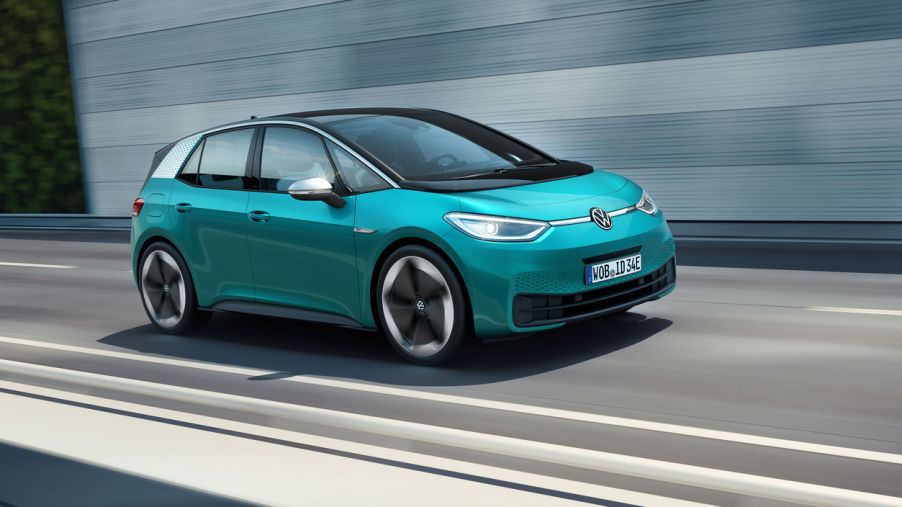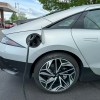
Tesla Model 3 vs Volkswagen ID3: How the Two EVs Compare
There isn’t much real competition among electric cars, but a new era is dawning. Volkswagen is getting in the game, even if some models will only be available in Europe. Even though the Volkswagen Group has already released electric cars under their other brands, such as the Porsche Taycan, this is the first electric VW. Recently, Volkswagen presented its new ID.3 at the International Motor Show in Frankfurt, Germany. Not only is this the company’s first model to join the new generation of pure electric vehicles, but it showcases the realigned brand and has the newly designed Volkswagen logo.
What the New Release Means for Tesla
These pure electric cars feature outstanding efficiency, full connectivity, and produce zero local emissions. According to the Head of Sales and Marketing for the ID family, Silke Bagschik, “The ID.3 is an all-rounder that is suitable for everyday use. It is compact, as such offering the maneuverability of a small car with the interior space of a mid-range vehicle. It combines exciting design with innovative technology and significant range.”
But how does this vehicle compare to another electric car on the road already? The Tesla Model 3 is a head-turner that its customers are already in love with. Will the Volkswagen ID.3 be able to outshine the competition? There seems to be potential for the ID.3 to be the car that gets the closest to comparing to the Telsa Model 3.
Comparing the Tesla 3 and Volkswagen ID.3
The first thing that is strikingly similar is the name. While it could automatically call it into competition, Volkswagen claims that the 3 stands for the fact that they are in their third era of car making. Both are meant to be entry-level electric cars and come in at around $35,000 each for the base models. While not all comparisons are apples to apples, here are some notable features of both cars.
- Market: Since the ID.3 isn’t being sold in the US, you can’t compare those markets, but Volkswagen has a strong presence in Europe and China, which are also Tesla’s major markets outside of the US.
- Base Price: The base model of the ID.3 will cost less than the Model 3 will cost, coming in at $33,000 after tax in Germany. The Tesla Model 3 comes in at a starting price of $36,200, which is before taxes.
- Variations: VW will be offering two variations of the ID.3 above the base model, while Telsa has four versions of the Model 3 in total.
- Mileage: The base range of the ID.3 will have a range of 205 miles on a 45 kWh battery, and at the top model, can get up to 342 miles. Tesla’s Model 3 comes in at the 240-mile range for the standard model.
- Driving Dynamics: With the battery positioned into the underbody of the ID.3, it improves the dynamics because the center of gravity is significantly lower. The ID.3 has optimum weight distribution as well. The Tesla Model 3 offers sharp handling, smooth acceleration, and also has the same underfloor battery that gives a lower center of gravity.
- Safety: The Model 3 received five-stars (a perfect score) from the National Highway Traffic Safety Administration, which doesn’t test non-US cars.
- Minimalism: Many view the ID.3 as less minimalist than the Tesla Model 3, but both are considered very minimalist inside.
- Features: The ID.3 includes a navigation system, a DAB+ digital radio, seat heating, and steering wheel heating, as well as armrests at the front, a Mode 2 charging cable, and 18-inch light-alloy wheels. The Tesla compares by offering 20-inch wheels with summer tires, upgraded brakes, a carbon-fiber spoiler, a lowered suspension, and a 10-mph increase in top speed (to 155 mph).
- Tech: This VW offers a more high-tech interior than its non-electric cars, even with the lower price point. Both the Tesla Model 3 and the ID.3 dismissed most of their physical buttons in favor of touch-sensitive buttons to control interior options. The central focus of the ID.3 is the 10-inch touchscreen in the middle of the dashboard, but the AR head-up display that shows up on the windshield and voice-activated controls add to the appeal. Other than some of these specific tech features, the ID.3 isn’t planning on anything for drivers’ assistance aside from automatic emergency braking, and lane assist functionality. Nearly everything is controlled in the Model 3 by the touchscreen in the center of the dashboard. It has standard automated emergency braking, lane departure warning, and adaptive cruise control.
- Comfort: The ID.3 is touted as a VW that will be similar to the Golf, but updated and roomier inside. The car will be compact but feel comfortable to ride in. It also will seat five. The Model 3 has supportive and comfortable front seats, but the rear seats are more cramped. The Model 3 also touts an impressive amount of room, stating that 15 carry-on suitcases can fit when the rear seats are folded.
- Brand-Specific Features: The ID.3 continues the tradition of the VW brand by having the car’s LED matrix headlights flutter the eyelids of the vehicle, giving it a human touch. For Tesla’s Model 3, the most well-known feature is the autopilot equipment.
Which Car Wins?
With all the features of the Volkswagen ID.3, it’s easy to see why it compares to the features offered by the Tesla Model 3. This may be the best challenger to date for Tesla’s Model 3, but deciding which to buy will come down to a personal decision and where you live. If you’re like Jay Leno, you’ll always and forever be a fan of the Tesla brand, and it might be hard to change the minds of loyal Tesla owners.


